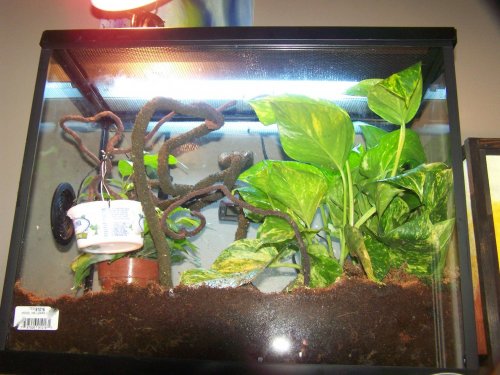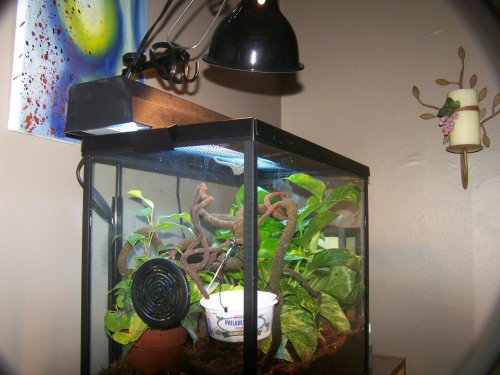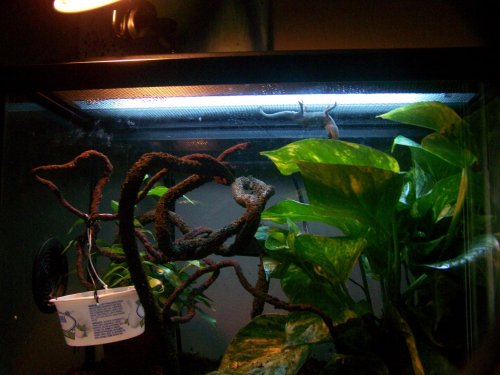Hi just thought I would post some pics of my enclosure with Maurice hanging upside down. I know it's a glass enclosure, the sides have vents and the top is screen. The reality is we live up north, this is the best way to keep the temps and humidity regulated in the winter months. Anyway enjoy and any creative feedback is appreciated.
Navigation
Install the app
How to install the app on iOS
Follow along with the video below to see how to install our site as a web app on your home screen.
Note: This feature may not be available in some browsers.
More options
You are using an out of date browser. It may not display this or other websites correctly.
You should upgrade or use an alternative browser.
You should upgrade or use an alternative browser.
Pics of my enclosure
- Thread starter Tooboo
- Start date
Lizardlover
New Member
NO SUBSTRATE! and im not sure if the vents will quite cut it. I just know definetly NO SUBSTRATE!
welcome to the forums
welcome to the forums
The substrate is nothing more than plantation soil. It will be removed shortly, I was kind of trying to reduce the size of his enclosure a bit, then remove some soil as he gets a bit bigger, eventually moving him to a bigger screen enclosure in a specific room in the house. It has also been doing as I expected, since it is a glass cage it absorbs the moisture, like a draining system. The pothos is planted directly in the soil, while the ficus is on top of the plantation/eco soil in a pot.
I haven't had impaction issues yet, since he is also cup feeding. He has pooped each day with nice white urate.
I haven't had impaction issues yet, since he is also cup feeding. He has pooped each day with nice white urate.
Syn
Avid Member
I haven't had impaction issues yet, since he is also cup feeding.
Yet. Keyword. Some curious chameleons decide to take a munch on substrate and get impacted.
BocaJan
New Member
You may also have things growing in the soil since there is no way to keep it dry. Put your plant in a pot and remove the rest of the soil. The enclosure is not too big for your cham. I also think that you need to get a screened cage or a mesh one. Your fella could be looking for some moving cool air. Until you get him into an all screen one, move your light bulb up and lower the wattage. You are creating an oven.
Arjan
New Member
Is it common in the US that you don't use any substrate at all?
I know that in Holland and some other countries in Europe that they all use substrate too maintain the humidity, for the plants, for the females for their eggs.
I haven't heard of any breeder or keeper that they lost a chameleon because they used a substrate except for bark.
I know that in Holland and some other countries in Europe that they all use substrate too maintain the humidity, for the plants, for the females for their eggs.
I haven't heard of any breeder or keeper that they lost a chameleon because they used a substrate except for bark.
sandrachameleon
Chameleon Enthusiast
Yes, it is common to suggest NO substrate
Substrate that is used to maintain humidity is, of course, damp or wet. This combined with the nice warm temp is a great place for bacteria and or mold to grow. Anything undigestable that is ingested (on purpose or accidenally) has the potential to cause impaction. There are better ways to maintain appropriate humidity.
Substrate that is used to maintain humidity is, of course, damp or wet. This combined with the nice warm temp is a great place for bacteria and or mold to grow. Anything undigestable that is ingested (on purpose or accidenally) has the potential to cause impaction. There are better ways to maintain appropriate humidity.
ciafardo 4
New Member
Topsoil is fine its not that bad come on.i wouldn't use it because its hard to keep clean but i dont think it poses a health risk
Lizardlover
New Member
I have to admit, with one of my first chams i had substate and a glass cage...he lives fine for 4 years, not that i would recommend it or ever do it again.
ciafardo 4
New Member
By clean i mean removin the turds and with all the watering it could get muddy but i dont think it causes impaction is what i mean to say.
Dunnigan
New Member
In my Pygmy enclosure, which has substrate and high humidity, did have a problem with a white fungus growing on the substrate. I solved this problem by placing a small fan by the enclosure, so that air was blowing over the top of the enclosure. It did lower the humidity but it solved the fungus problem...
I have read that some chameleons will actually eat dirt, from what little research i have done, it seems that they do this to help get minerals and nutrients. The time i have heard of this was from a Meller's cham.
Just my 2 cents
I have read that some chameleons will actually eat dirt, from what little research i have done, it seems that they do this to help get minerals and nutrients. The time i have heard of this was from a Meller's cham.
Just my 2 cents
OntarioLizardman
New Member
putting the substrate debate aside, it is a neat little cage
never seen biovines quite like that.
never seen biovines quite like that.
Is it common in the US that you don't use any substrate at all?
I know that in Holland and some other countries in Europe that they all use substrate too maintain the humidity, for the plants, for the females for their eggs.
I haven't heard of any breeder or keeper that they lost a chameleon because they used a substrate except for bark.
This is what I thought, and there is no bark in there. if impaction is your worry then the bio vines and the likes should be taken out of enclosures since a Cham could potentially put their tongues on it and ingest some of the flaky pieces of it. Could they not just as easily ingest some of the dirt from potted plants? Just a thought.
crablady
New Member
i don't get it. i know i'm new so i'm just learning myself. But why are chameleons so much more at risk of impaction. i have all my fat tailed geckos and crested geckos with substrate. my cresties are in fully planted terrariums. my fat tailes are with a mix of sand and EE and they are ground dwelling, not aboreal. i know many people with leopard geckos that use sustrate. EE/plantation soil and the likes are digestible. and the chams as we all know are aboreal and seem to stay higher up in the plants.
Is it common in the US that you don't use any substrate at all?
I know that in Holland and some other countries in Europe that they all use substrate too maintain the humidity, for the plants, for the females for their eggs.
I haven't heard of any breeder or keeper that they lost a chameleon because they used a substrate except for bark.
I agree.
In Germany the majority of Chameleon owners use a "special" type of substrate:
Basically what we do, is we go to the next forrest and dig out a barrow full of fresh forrest earth and chuck it into the enclosure.
Some people might cry out: "What the hell are you doing? Don't you know that this dirt is full of bacteria, slugs and other creepy-crawlies?
Yes, and thats excellent
I'll touch upon this topic later.
Let's first have a look at the clean US-way, without any substrate:
Because the bottom of the enclosure is wet, doodoo, leafs and dead feeders start to mold and a monoculture of bad germs can develop so that we consantly have to clean and disinfect our enclosure.
Meaning that we have to take out all of the plants and the chameleon out of its home every day, in order to clean it, which is connected with a lot of stress for the chameleon, shortening its lifespan and a lot of work for the keeper too.
Lets imagine we use a normal substrate like potting soil. The substrate will suck up most of the substrate, but dead feeders and poo still continue to rott unseen in the corners, so we still have to clean or swap the substrate regularly.
Now it's time to comeback to our forrest earth. In nature there is a variety of invertebrates and microorganisms called destruents, who rapidly start decomposing pieces of dead plants, or animals. And we can make use of them, through introdduncing them to our terrarium. These microorganisms prevent bad germs from reproducing in big amounts, and decompose poo and leafs in less than a week. If you're concerned about parasites, i can reassure you that it is very unlikely, that there are any parasites in the earth that could harm your chameleon, since most parasites are specific concerning their host. Additionaly the level of humidity is raised.
Of course good Drainage is very important too, the earth should never become to marshy.
On impaction: Small amounts of earth occasionly shot whilst hunting, normaly won't harm your chameleon (Im talking 'bout earth not Retibark or similar crap). If it deliberately starts too eat earth, then you must consider your supplementation.
I'm aware there isn't just one way of chameleon husbandry, but as soon as people start to cry out "no substrate", or "no glass", I would like to put in my point of view.
with best wishes,
albacheck
Sancho
New Member
Why risk impaction? Just eliminate the substrate... think of the cham, not how it looks, etc.
I agree! When I first bought my cham Petco told me to use substrate and no uvb and well my cham ended up dying! I highly suggest not using it.
Similar threads
- Replies
- 21
- Views
- 3K
- Replies
- 15
- Views
- 2K
- Replies
- 2
- Views
- 935








